
Newsletter
Autumn 2010

 |
Newsletter |
 |
Generally the garden for garden enthusiasts is a place of constant striving, introducing a new project, trying to collect or encourage some rare, difficult-to-grow plants. We plan our gardens to give views, quiet areas where an attractive seat can be placed, one that we will rarely sit on. I have been using my garden as a peaceful refuge recently. The pleasure of being able to escape, into a brimming border, to control a small part of life. Here the talk of the leadership challenges, reduction in numbers, redundancies, and economies of scale have very little effect on the annual cycle. Mistakes made this year can be rectified, dictators can be quietly removed, thugs reduced in number, and sharing produce and oversized plants with friends prevents the guilty feeling when digging up a too-successful plant.
Our summer programme has been varied and challenging. Our three brave members who opened their gardens to the society for coffee mornings allowed us to relax in wonderful gardens. They must have been good because the weather agreed and we enjoyed lovely mornings. We searched for old train tracks at Margaret Lewis': Network Rail could take some advice on landscaping tracks from Margaret. John and Vivienne McGhee have transformed their plot in a very short time. The quietly babbling rill is so John and Vivienne, constantly on the move, leading the eye round the garden. Poor Linda had to cope with drought conditions just before her open day. However when in the garden it was not apparent. The secluded and well stocked garden provided secrets for all. A major fascination were the badger deterrent devices, but the surprise was on getting to the end of the garden and finding a large vegetable plot capable of supplying Ambridge Organics.
Our summer meeting programme has been full of shocks for Angela Downton. Twice the speakers have let us down at the very last moment - in June and September. However Angela D, Judy and David P came to the rescue and we enjoyed exciting last-minute lectures. Sue Chitty provided an excellent day out in Shropshire: two contrasting gardens, the first all form and structure of a size most of us could relate to; the second a dream of what high finance could provide: amazing gates, buildings and fences complemented the lavish planting.
So we approach winter, a time for gardeners to think of past successes and plan for future ones. Spare a thought for your society, plan to give it a little help in 11/12. That could be physical, helping to set up the room, make a cake, wash up, grow some plants to sell or come on the committee with ideas. It could be social, talk to others about our group, bring a friend along, offer to host a meeting. Most importantly, come along to meetings and make the day fun and informative.
Subscriptions to the Group become due on 1st January 2011 and can be paid either on the door at a meeting or by post to my address at Half Acre, Main Street, Worcestershire, WR11 7XB. Cheques to be made payable to 'HPS Worc's Group'.The sub remains the same at £12.50 and admission to the meetings is free. It would be helpful if you are able to give me a post-dated cheque at our December 2010 meeting. This would ease the burden on the door in January 2011. Remember membership of the Group is conditional on being a member of the national Hardy Plant Society.
We have another bumper autumn edition this year, with reports of our activities, as well as articles more directly connected with plants. Thank you to all who have contributed, and especially to Leila, who has again printed the photos in the centre pages. The AGM documentation is overleaf, and a selection of the limericks from the Cornish trip appear at various places.
With a non-Hardy Planter friend (I know, I have tried to recruit her) I visited a mutual friend (who gardens, and now that she's retiring might be more inclined to be recruited) in Callander in Scotland in September. While browsing in a splendid secondhand bookshop on a rainy morning, I found an early copy of one of Gertrude Jekyll's books, superbly rebound and with a price tag to match, and then a copy of the HPS Journal for Spring 2002, priced £1. I like to think that someone interested in hardy plants might pick it up, enjoy it and join us.
Finally, the copy date for the spring edition, which will be available at the March meeting, is 12 February.
This year’s garden tour to Cornwall was the most thoroughly researched and carefully planned of all the tours I have organised for the Group yet even the best laid plans of mice and men ..... Perhaps the weather was an omen.
We had been blessed with fine sunny weather for a number of weeks yet as the day of departure neared the ominous words “warm front” and “rain” began to appear in the forecast. And sure enough, as we headed south and west the skies darkened and by the time we reached our first garden, the Garden House at Buckland Monachorum, the heavens had opened. But you can’t legislate for the weather and we are, after all, hardy planters.
The first hurdle for our unlucky driver, Graham, was the narrow road we encountered on leaving the Garden House, a challenge exacerbated by the assortment of vehicles parked down one side.
Now our coach, as Graham had proudly explained, was brand new and had cost £135,000. To have returned it other than in an unblemished condition would have dented his professional pride and incurred the wrath of owner Chris Dudley. It was unsurprising therefore that he baulked at the challenge and it was only by dint of folding away the mirrors of the parked vehicles and guiding him through inch by inch that we escaped unscathed. But that, like the grounding of the coach as it negotiated the drive on arriving at the hotel, was a minor incident compared to the travails that still awaited our hapless driver.
Involving travel by both land and sea, next day’s itinerary might have appeared ambitious but timings had been calculated with generous margins and a Plan B worked out, for example, had the ferry service from Falmouth to St Mawes been suspended due to bad weather. Now, air crashes are usually the product of a rare combination of random circumstances and our near-miss should be viewed against this backdrop. A delayed departure due to a simple human error became compounded by idiotic signposting in Falmouth and led us to abandon the coach and dash through the streets of the town to the quay. Bemused shoppers looked on waiting for the collecting tin to be thrust under their noses. It had to be a charity run for Help the Aged. But time was of the essence. A phone call to the captain of the ferry had established that he could only delay his scheduled departure by five minutes at most due to the tide. Like “Health and Safety”, you can’t argue with the tide.
The word “dash” could only be applied in a figurative sense to our party and the line quickly became severely stretched. Yet the ferry was still tied faithfully to its moorings as the vanguard raced onto the quay. It takes a long time to board a party of forty five, negotiating the uneven and slippery stone steps, and the last of the main group had just stepped onto the deck as the stragglers and walking wounded in the rear, gallantly aided by their trusty comrades, hove into view. We’d made it! Let no one say that the spirit of Dunkirk doesn’t live on!
Meanwhile, poor Graham had been left to reverse, unaided, out of the narrow cul de sac where we had abandoned him. I hope it wasn’t the stress that caused an attack of a recurrent illness as he drove us back to the hotel and occasioned two emergency stops. As I bought him a beer that evening I hesitated to ask how he had managed to extricate himself from the back streets of Falmouth. It had taken him “some time”, he confessed; Graham, a master of the understatement.
Well, it could and did get worse. Following the only recommended coach route to Caerhays Castle the next day, we became impossibly stuck on a narrow bend and something had to give. Unfortunately it was the shiny new coach.
Before the trip I had cautioned against allocating us the pride of their fleet but the coach operator had wanted to offer us his best. Whilst it was 1.5 metres longer than their standard coaches, he reasoned, it was 5 cm narrower and had a good lock. Unfortunately there comes a point where the geometry of the variables is such that it becomes a physical impossibility for a rectangular block of given dimensions (coach) to negotiate a path created by two arcs with differing radii (road). We had reached that point.
The only consolation for Graham was the unbridled admiration of a local off-duty coach driver he met at the car park. None of the local coach drivers willingly volunteer for trips to Caerhays, it appears, and only ever take 28-seaters. Ours was a 48-seater.
After that it really did get better. My fears about the approach to Cothay Manor down the narrow Somerset lanes proved groundless and I was able to manhandle the fallen tree, a product of the gale, into the bank without too much difficulty (but where was the help?!) And having opened by stating that you can’t legislate against the weather, even the bitter north wind at Plant World was tempered by the shelter in “Siberia”, the warmest spot. My main concern now is who are we going to get to drive us round Sussex next year?
Many Hardy Planters, when looking for plants to fill gaps in their borders, will choose unusual, newly introduced, or rare plants from the sales tables, rather than more familiar easily obtained plants of the kind listed in the Plant Finder as, 'widely available'. The majority of these are AGM plants, gaining this accolade because they are reliable performers, well tested over varying conditions. It is only natural to look for something different, but we should not necessarily neglect the familiar in favour of the exotic.
I well remember when we first joined the Southern Counties group of the HPS some 20 years ago, the Lady Chairman at the time, after chiding members for the poor quality of the plants brought for sale - yoghurt pots and lack of labels were mentioned,- then went on to say, 'and I don't want to see another Alchemilla mollis here'. I feel Achemillamollis is a much maligned plant which has many good points, not the least being its ability to grow almost anywhere. 'Bomb proof', as Bob Brown would say. The leaves are most attractive and the foamy flowers not without merit, and I would suggest, if it was extremely rare, we would all be trying to acquire one!
I made a note of the hardy perennials which had performed best in our garden in 2009, taking into account impact, duration of flowering, foliage and freedom from pests and diseases, and, not surprisingly, my top six are all 'widely available' plants. They are:
1.  Aster frikartii 'Monch' - all the gardening writers and gurus mention this as a 'must have' plant in everyone's garden. The soft mauve daisy-like flowers with a yellow boss start opening in July and it goes on blooming into November. If it has a fault it is that it can sprawl a little, once it has achieved its full height of 3 - 4 ft, but being a tidy gardener I give it support before this happens. I have two substantial clumps in the garden.
Aster frikartii 'Monch' - all the gardening writers and gurus mention this as a 'must have' plant in everyone's garden. The soft mauve daisy-like flowers with a yellow boss start opening in July and it goes on blooming into November. If it has a fault it is that it can sprawl a little, once it has achieved its full height of 3 - 4 ft, but being a tidy gardener I give it support before this happens. I have two substantial clumps in the garden.
2. 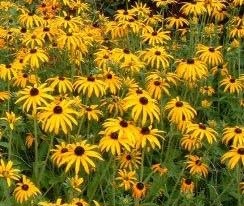 Rudbeckia fulgida v 'Deamii' - also praised by the experts for the longevity of its floral display and the fact that it is not fussy about location. The yellow flowers with a black eye stand erect to about 2ft without any support, blooming from the late summer well into the autumn. We have a large clump which we can enjoy from the kitchen window.
Rudbeckia fulgida v 'Deamii' - also praised by the experts for the longevity of its floral display and the fact that it is not fussy about location. The yellow flowers with a black eye stand erect to about 2ft without any support, blooming from the late summer well into the autumn. We have a large clump which we can enjoy from the kitchen window.
3. Geranium 'Anne Thomson' - with so many good cultivars in the genus, you would have to have a representative in the list of top performers, and this one is a favourite. Very similar in many ways to 'Ann (without an 'e') Folkard' but, in my opinion, a better plant. It sprawls happily around its neighbours and the psilostemon-like flowers cover it from summer to early winter when it can be cut back to ground level. Completely trouble free.
Geranium 'Anne Thomson' - with so many good cultivars in the genus, you would have to have a representative in the list of top performers, and this one is a favourite. Very similar in many ways to 'Ann (without an 'e') Folkard' but, in my opinion, a better plant. It sprawls happily around its neighbours and the psilostemon-like flowers cover it from summer to early winter when it can be cut back to ground level. Completely trouble free.
4. 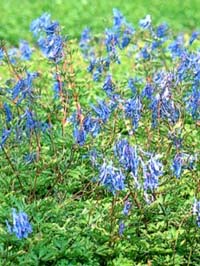 Corydalis flexuosa 'Pere David' - as you know, the first blue corydalis came on the scene about 15 years ago, and for a while was all the rage, the nursery shelves bursting with stock. But then, two or three years later, it virtually dropped out of sight. One could almost write a book entitled 'The Rise and Fall of the Blue Corydalis'! Why was its period of popularity so short lived? Probably because many people who bought it very quickly lost it, and it gained the reputation of not being truly perennial. I find it does not like too much direct sunlight, preferring semi-shade where it is not too dry. Like all corydalis the foliage is most attractive. It comes into flower quite early, and goes on for some weeks. In autumn, when it is beginning to look tired, I cut it to the ground, give it a dusting of Fish, Blood and Bone, and then well before the winter it will sprout a fresh crop of leaves. It is very easy to propagate: just dig out a piece and pot it up. A really good plant, although the colour is a little difficult to place.
Corydalis flexuosa 'Pere David' - as you know, the first blue corydalis came on the scene about 15 years ago, and for a while was all the rage, the nursery shelves bursting with stock. But then, two or three years later, it virtually dropped out of sight. One could almost write a book entitled 'The Rise and Fall of the Blue Corydalis'! Why was its period of popularity so short lived? Probably because many people who bought it very quickly lost it, and it gained the reputation of not being truly perennial. I find it does not like too much direct sunlight, preferring semi-shade where it is not too dry. Like all corydalis the foliage is most attractive. It comes into flower quite early, and goes on for some weeks. In autumn, when it is beginning to look tired, I cut it to the ground, give it a dusting of Fish, Blood and Bone, and then well before the winter it will sprout a fresh crop of leaves. It is very easy to propagate: just dig out a piece and pot it up. A really good plant, although the colour is a little difficult to place.
5.  Phlox carolina 'Bill Baker' - not perhaps, quite as showy as the paniculata varieties, but with much better foliage and lower growing. The flowers are a shade of shocking pink, and when in bloom in early summer it is a fine splash of colour. In my experience, trouble free. The clump slowly increases in size.
Phlox carolina 'Bill Baker' - not perhaps, quite as showy as the paniculata varieties, but with much better foliage and lower growing. The flowers are a shade of shocking pink, and when in bloom in early summer it is a fine splash of colour. In my experience, trouble free. The clump slowly increases in size.
6. 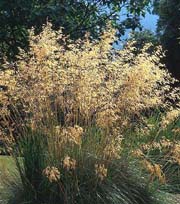 Stipa gigantea. - the giant oat. I am fond of grasses but this is the best of them all. The secret is in the placement. Tucked away in a mixed border it is lost, but in isolation, where it stands out and the 6ft plus inflorescences can be seen against the sky, it is magnificent. It makes a splendid wind gauge, the stems swaying in the slightest breeze. The tall stems last until the autumn gales snap them off. It is not particular about soil and the only maintenance required is a good combing with a wire rake, early in the year, to remove dead leaves.
Stipa gigantea. - the giant oat. I am fond of grasses but this is the best of them all. The secret is in the placement. Tucked away in a mixed border it is lost, but in isolation, where it stands out and the 6ft plus inflorescences can be seen against the sky, it is magnificent. It makes a splendid wind gauge, the stems swaying in the slightest breeze. The tall stems last until the autumn gales snap them off. It is not particular about soil and the only maintenance required is a good combing with a wire rake, early in the year, to remove dead leaves.
There are many other 'widely available' plants, but the above are personal favourites.
Friday the 18th June dawned bright and sunny as we set off from Peopleton Village Hall. Once on the road we travelled through the Worcestershire countryside via Worcester and Kidderminster and on into Shropshire until we reached our first destination of the day, Windy Ridge at Little Wenlock. We were warmly welcomed by Fiona and George who not only provided coffee and biscuits but introduced us to their wonderful garden and provided a spotters' list of everything they had planted.
Free to explore this treasure trove of a garden, there was much to be enjoyed. From the work in progress on the sweeping driveway up to the front of the house, the surprise of giant welly boots in a hidden corner, the mini topiary garden reflecting the window design, the relaxing deck reaching out over the pond, to the pathway that took you around the edge of the garden and the pond at the same time, offering a different view at each and every turn.
In amongst the planting were various sculptures and other unusual touches. The delicate ‘iron lady’ and the ‘bouncy chairs’ on the decking were just two of my favourites!
For those of us who took the opportunity of a comfort break, we were treated to a spectacular ‘Room with a View’!
Our tour continued with a lunch stop and chance to shop at Percy Thrower’s Garden Centre. This huge emporium had just about everything a gardener could want!
Continuing 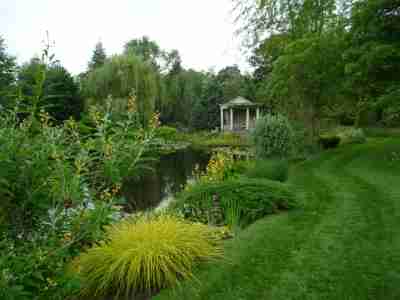 to the west of Shrewsbury, our destination this time was the garden of Cruckfield House. We were once again warmly welcomed by the owners, Mr. and Mrs. Cobley. After a short introduction from Mr. Cobley, even a bit of rain couldn’t dampen our enthusiasm for exploring this lovely four acre garden with its different settings. The lake, complete with a temple-style building at one end, the kitchen garden and the large rockery garden were just some of the areas to be enjoyed, all set in secluded pasture land. The courtyard fountain garden was the perfect place for afternoon tea and delicious homemade cakes provided by the League of Friends.
to the west of Shrewsbury, our destination this time was the garden of Cruckfield House. We were once again warmly welcomed by the owners, Mr. and Mrs. Cobley. After a short introduction from Mr. Cobley, even a bit of rain couldn’t dampen our enthusiasm for exploring this lovely four acre garden with its different settings. The lake, complete with a temple-style building at one end, the kitchen garden and the large rockery garden were just some of the areas to be enjoyed, all set in secluded pasture land. The courtyard fountain garden was the perfect place for afternoon tea and delicious homemade cakes provided by the League of Friends.
Homeward bound, we made a short detour around Bewdley to see a fabulous poppy field in full bloom and last, but not least, the Blackstone Rock complete with the England flag!
Wonderful day!
Many thanks to our garden hosts, Pepe our driver, the League of Friends and especially to Sue for organising it all.
Last year at Gillian Stone's coffee morning I admired some yellow daisies growing in her borders. She told me they were Rudbeckia 'Prairie Sun'  and were grown from seed from Thompson and Morgan. Described in their catalogue as 'spectacular bright orange petals fading to pale lemon yellow tips with a striking green central cone' I decided to have a go at growing some myself. Rudbeckias are easy to grow from seed - I have previously grown 'Rustic Dwarfs' and 'Cherokee Sunset' (which I have seen at Malvern selling for £4 a plant) - and more to the point I had a border on the front garden to fill after a large weeping silver birch was felled in December. They have made good bushy plants covered in long-lasting flowers and have been a great success. My only (minor) criticism is of the catalogue description as I would describe the orange petals as more egg yolk yellow. If you have gaps in your summer borders why not give them a try?
and were grown from seed from Thompson and Morgan. Described in their catalogue as 'spectacular bright orange petals fading to pale lemon yellow tips with a striking green central cone' I decided to have a go at growing some myself. Rudbeckias are easy to grow from seed - I have previously grown 'Rustic Dwarfs' and 'Cherokee Sunset' (which I have seen at Malvern selling for £4 a plant) - and more to the point I had a border on the front garden to fill after a large weeping silver birch was felled in December. They have made good bushy plants covered in long-lasting flowers and have been a great success. My only (minor) criticism is of the catalogue description as I would describe the orange petals as more egg yolk yellow. If you have gaps in your summer borders why not give them a try?
There was a young lady named Sue
Who only liked plants coloured blue
When her friend planted yellow
She moaned at the fellow
And said he had ruined her view.
As I gradually grow older, or more kindly, mature, I am beginning to admire deeper colours in the garden - not the bold harsh pinks, oranges and yellows of azaleas and rhododendrons, but the lovely brownish-red colour of baked earth. It came 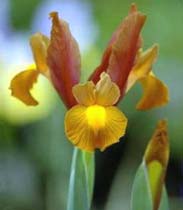
Dutch iris 'Bronze Beauty'about because I have three Rosa mutabilis in my roadside border and in order to highlight the sepals of this single rose I found an erysimum in a lovely burnt terracotta colour. I have lost its label but it has flowered continually from late May and is still looking good in late September, having had the odd trim.
I am now moving into the world of heucheras. They are just the colour I am after and a choice of 'Ginger Ale' or 'Caramel' - the undersides of the latter reflecting the deeper shade of the rose petals. Heleniums, hemerocallis and Viola 'Irish Molly' all fit into this scheme of things. And joy of joys, there is a glorious Dutch iris 'Bronze Beauty' which will lift my spirits in June. These will follow on from pots and tubs of the tulip 'Ballerina' which I tried last year to accentuate various strategic points in the garden. Wonderful.
Gardening life does get better, but I haven't moved into the world of grasses yet. I still feel they are better in the wilds of New Zealand.
The other day, when browsing through some Newsletters and various papers from the time we were members of the HPS Southern Counties group, I came across the following poem. It is a light-hearted dig at serious gardeners, who allow their interest to become an obsession to the detriment of more mundane tasks, and is both amusing and worth repeating for the benefit of our members.
Unfortunately I cannot give due recognition to the author, as the editor of the Southern Counties Newsletter admitted at the time it was published that she had forgotten who gave it to her, but Dee Folkard, their current Chairman, has given us permission to reproduce it here.
My Wife the Gardener
She dug the plot on Monday, the soil was rich and fine,
She forgot to thaw out dinner, so we went out to dine.
She planted roses on the Tuesday, she says they are a must,
They really are quite lovely, but she quite forgot to dust.
On Wednesday it was daisies, they opened in the sun,
All pinks and whites and yellows, but the laundry wasn't done.
The poppies came on Thursday, a bright and cherry red,
I guess she really was engrossed, she never made the bed. ,
It was violets on Friday, in colours she adores,
It never bothered her at all, the crumbs upon the floors.
I hired a maid on Saturday, my week is now complete.
My wife can garden all she wants, the house will still be neat.
It's nearly lunchtime Sunday and I cannot find the maid,
Oh no! I don't believe it, she's out there WITH THE SPADE!
Next year’s garden tour will be to Sussex and the Kent borders. Departure will be on Wednesday 15th June, returning on Sunday 19th June, four nights. Accommodation on a dinner, bed and breakfast basis has been booked at the Jarvis Ramada Hotel outside Tunbridge Wells. This is a modern, well-appointed hotel, in a quiet location, and with rooms of a very good standard. There is also a large swimming pool. It is an ideal base from which to visit the selected gardens without excessive journey times.
As before, I have tried to include a mix of gardens including world-famous ones such as Sissinghurst and Great Dixter along with Wakehurst Place, managed by Kew and housing the Millennium Seed Bank. Sussex boasts a wealth of wonderful privately owned gardens of which we shall be visiting Bankton Cottage, Bates Green, Rose Cottage, Merriments, Town Place and finishing with theatrical and evocative Clinton Lodge. For readers of the 'Saturday Telegraph', we will also be visiting Sarah Raven’s cutting garden at Perch Hill Farm. There will be plenty of opportunities to buy plants at many of the venues and we shall be making stops at two highly recommended local nurseries, Marchants and Perryhill.
Whilst I have secured an excellent deal from the hotel, the garden entrance charges in the South East are higher than we have been accustomed to paying. Some of the charges for 2011 have yet to be confirmed but I anticipate a cost per person (sharing) of £370 with a reduction of £20 for National Trust members and a single room supplement of £72. This includes refreshments at many of the venues and two light lunches.
Please use the booking form inserted in the printed version of this newsletter or contact me to secure your place. Confirmation and full details will follow in the New Year.
Fashionable Gardeners
There once was a lady called Wendy
Who with Leila, her friend, was quite trendy.
They bought lots of plants
For themselves and their aunts
That were tall and airy and bendy.